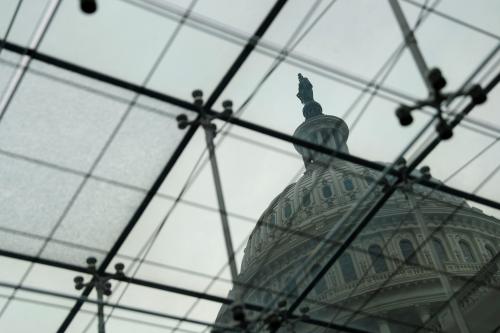Donald Kohn and Nellie Liang, both of the Hutchins Center on Fiscal & Monetary Policy at Brookings, prepared a paper, “Understanding the Effects of Stress Tests,” for a Federal Reserve conference on stress testing held July 9, 2019, at the Federal Reserve Bank of Boston (slides here). They analyzed stress test disclosures, reviewed research on the stress tests, and interviewed market participants and former regulators and bankers. Here’s a Q&A with David Wessel, director of the Hutchins Center, in which the authors summarize their findings.
Q: Stress tests of banks – presenting them with an unpleasant macroeconomic and market scenario to see if they have enough capital to withstand a severe economic storm – played an important role in ending the worst moments of the global financial crisis in 2009. As you write in your paper, they led banks to raise capital so they had the financial strength to lend. They also bolstered public confidence in the banking system. Ten years later, the government is now doing stress tests regularly. Do you think they are helping to prevent a repeat of 2008-9? What’s your bottom line?
A: The tests have evolved considerably since 2009, but the underlying rationale remains the same–to assure that major banks can continue to supply credit to households and businesses in circumstances of deep economic and financial distress. As in 2009, the tests look at the effects of a severe economic downturn on banks’ capital—their ability to absorb unexpected losses and continue to lend, avoiding sharp cut backs in credit that would only make a really bad situation worse. A freezing up of credit in 2008 from banks and nonbank sources caused problems in the subprime mortgage market to spread throughout the U.S. financial system, leading the government to provide capital to banks and, of course, to the very deep recession. If a bank is found not to measure up in the stress test, it must figure out how it will get the required capital, usually by cutting back on the amount of capital it is planning to distribute to its shareholders in dividends and share buybacks.
The tests are helping to prevent a repeat of the financial crisis by requiring banks to hold enough capital to continue to lend in a hypothetical severe macroeconomic recession and to demonstrate strong risk management practices for capital planning.
The tests are helping to prevent a repeat of the financial crisis by requiring banks to hold enough capital to continue to lend in a hypothetical severe macroeconomic recession and to demonstrate strong risk management practices for capital planning. But stress tests are only one of several reforms that are working in that direction, including the Basel III increases in capital requirements, new rules requiring banks to hold ample liquidity, and derivative market reforms.
Q: Have stress tests encouraged banks to build capital when times are good so they can absorb losses when times are bad, and still keep lending?
A: Yes, capital requirements from the stress tests have risen on balance through 2018, though perhaps more because of the requirement that banks pre-fund their proposed dividends and share repurchases than because of the countercyclical macroeconomic scenarios. There’s a natural tendency for banks to ease up on the capital they want to hold in good times, when loans are being paid back and risks look low. The tests counter that by asking what would happen to losses if good times turn really bad. In the scenarios for the tests, the better the current environment, the bigger the stress. For example, if the unemployment rate is 7 percent, the scenario will include an increase in the unemployment rate of 3 to 5 percentage points, to not less than 10 percent. But if the current unemployment rate is lower, for example at 4 percent, the increase will need to be larger to reach a minimum of 10 percent. That is, the lower the actual unemployment rate, the greater the increase. Another powerful countercyclical force is the stress test requirement that banks show they have enough capital to pay planned dividends and share repurchases. Shareholder distributions have been rising sharply in the past few years, especially for global systemically important banks (GSIBs), to about 1.8 percent of risk-weighted assets in 2018, contributing substantially to the capital requirements demanded by the stress tests. These two features of the stress tests have contributed to the capital ratios of the largest banks relative to risk-weighted assets staying flat, rather than declining, as might have been expected as loan quality has improved during the economic expansion.
Q: The 2019 stress test results were released recently. Did the countercyclical pattern you saw up to 2018 continue to hold?
A: No. The capital requirements from the stress tests fell in 2019, though they are still modestly higher than in 2014. We do not yet have the details to estimate the size of projected dividends and share repurchases, as we do for 2014-18. But we can infer that the net losses from the economic and financial stress scenarios were lower than in the previous year, even as the macroeconomic scenario anticipated a larger increase in the unemployment rate than the previous year’s scenario did.
Q: Have the stress tests improved risk management and capital planning at institutions that undergo them?
A: Yes. Our interviews indicated that market participants universally believed that stress tests have led to significant improvements in risk management at banks. Banks are focusing much more on tail risks in loan books and have greatly improved their ability to model the capital effects of these risks. Risks are being assessed holistically across the entire institution, whereas before they had been mostly viewed on a division by division basis. In addition, upper management and boards of directors now are more closely involved in risk management and capital planning on a forward-looking basis. The Fed has tied its approval of intended dividends and share buybacks to both a quantitative assessment of a bank’s vulnerability to the Fed’s severe stress scenario, and a qualitative assessment of the bank’s ability to manage its own particular set of risks. The people we talked to agreed that the public character of these qualitative assessments was a strong motivator for many of the improvements in capital planning processes. The Federal Reserve has decided to forgo the public assessment of capital planning in favor of folding such judgments into the more private supervisory process. It remains to be seen whether this change will lead to backsliding on aspects of the capital planning processes.
Q: Have the stress tests raised the cost and reduced the availability of credit from the largest banks?
A: While most studies are not able to isolate the effects of stress tests from other regulatory changes, higher capital requirements for the largest banks have prompted a reduction in the supply of credit, especially to riskier borrowers. Offsetting that, smaller banks, which aren’t subject to stress tests, as well as financial institutions outside the banking system, have increased their share of local market-wide lending, even for small businesses. And larger businesses have seen quite generous credit availability in bond and leveraged loan markets.
A reduction in credit may be a feature, not a bug, of the stress tests.
A reduction in credit may be a feature, not a bug, of the stress tests. Credit growth was unsustainably high before the financial crisis. The post-crisis reforms basically traded the expectation of lower credit growth for reducing the probability that the largest banks would fail, the ones whose failure would do the most harm to the economy. None of the studies have evaluated the welfare effects of credit being provided by the largest banks versus other providers.
Q: It’s been ten years since the Great Recession ended. The U.S. is now enjoying the longest expansion since record-keeping began in the mid-19th century. Do we need to wait for the next downturn to tell for sure how well the stress tests are working?
A: Yes. That’s the ultimate test. Until we have another recession, we won’t know for sure that a major objective of the stress tests — to assure that banks don’t amplify a downturn by pulling back on lending when it is most needed – has been achieved. To raise the odds that the stress tests work as designed and to guard against complacency as the memory of the Great Recession fades, it’s important to make the stress-test scenarios more stressful as the economy improves – that is, to project a bigger rise in the unemployment rate and greater loan losses – and to ensure that banks have prefunded dividends and buybacks in a way that makes that capital available should a bank need to draw on it in a recession.
Q:What are some of the biggest unanswered research questions about stress tests?
A: Stress tests are a major post-crisis innovation in supervision. It is important that they be reviewed regularly to see if they are having their intended effects. Research in a number of areas could be very helpful to ensure they maintain their role to strengthen the banking system and avoid destabilizing the economy. A few questions include:
- What will be the effects of actual and proposed changes in the stress test program on stress test capital buffers? How would changes in pre-funding shareholder payouts affect the level and countercyclicality of capital requirements from stress tests?
- Have banks’ business models become more similar as a result of the stress tests? Is there evidence of increased sensitivity to the same macroeconomic risks, or evidence that banks are ignoring risks not captured in the stress tests?
- What are the long-run effects of higher capital requirements on the largest banks on aggregate credit supply and welfare?







Commentary
Understanding the effects of bank stress tests: A Q&A
July 8, 2019